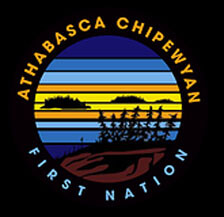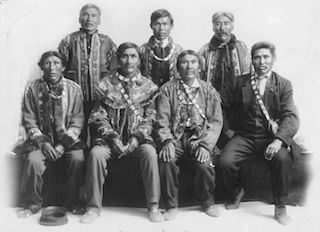In the past, this language family was simply known as the
Athabaskan language family, which is the name recognized by
most speakers of these languages (the spelling "Athabascan" is
more preferred today, but both spellings are still commonly
used, and "Athapaskan" can occasionally be seen as well.) But
once it was discovered that non-Athabascan languages (like
Tlingit, Eyak, and possibly Haida) were also related,
linguists began using the new term Na-Dene to refer to the
language family instead. The name Na-Dene was created by
combining the word na, which means "people" in Tlingit and
"home" in Haida, with the word dene, which means "people" in
several Athabascan languages.
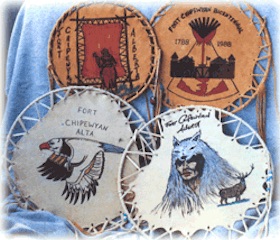
Alaskan Athabascans
Alaskan
Links
Athabascan Links
Athabascans of Interior Alaska
Chipewyan
Indian Culture and History
Chipewyan Indian Mythology
Chipewyan Women: Arctic Dawn
Chipewyan (chi-pah-way-en) is a Cree
word describing their pointed hats or clothing. Dene (den-ay)
or Dene suline are also used as names refering to Denendeh
meaning "Spirit that flows through this land from the
Creator". They also refer to themselves as Ethen-eldeli, or
caribou-eaters. Written history of the Chipewyan can be traced
back to the establishment of trade with European fur settlers
as far back as 1716, after establishing some peace with the
Cree, who fought the Chipewyan for fur hunting territory.
The Chipewyan historically occupied the Manitoba Hudson Bay
Area to the Slave River, but have spread throughout Canada for
various reasons. The Chipewyan, or Denesuline, practice
traditional survival techniques and traditions. These include
hunting available game, tea dances, feasts, and so forth. The
Denesuline are also well known for their artistic crafts made
from animal hides and birch bark, as well as their talent for
music and other arts.
The Chipewyan, or Denesuline, practice traditional survival
techniques and traditions. These include hunting available
game, tea dances, feasts, and so forth. The Denesuline are
also well known for their artistic crafts made from animal
hides and birch bark, as well as their talent for music and
other arts. The Dene are estimated to have inhabited the
Northwest territories since the Ice Age, because of oral
histories referring to a time of only winter.
Denali Story
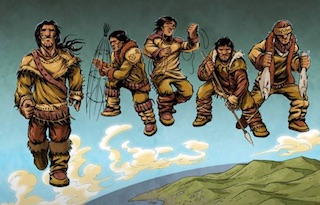
Fort Chipewyan Indian Band
Four
Directions Institute
Tanacross Athabascan Language Resources
Tetlin As I Knew It

View
of the Past
The Hero of
the Dene
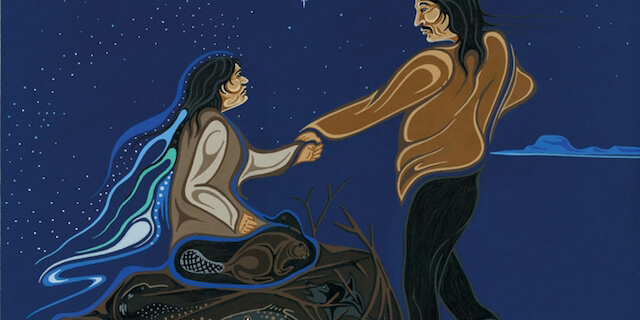
Dene Creation Story
Dene - Creation of Seasons
The first people of the earth had to endure winter for the
entire twelve months of the year. Most of the land was
covered by massive, moving layers of ice and deep snow. No
trees or bushes, or flowers could survive in the harsh
gripping cold. The lakes and rivers were frozen, so no water
flowed. It was a land of endless cold. One day when the
first people were out hunting they came upon a bear who had
a sack around his neck. The hunters were very curious and
asked the bear what was in the sack. The bear growled a
reply that he had a sack filled with the abundance of
summer's warmth and light. The hunters wanted the sack and
offered to trade, but the bear would not part with his sack.
The hunters begged the bear, but still he refused to give up
his sack. When they saw that it was useless to argue any
longer, they decided to return to their people and think of
some plan to take away the coveted sack. The chief heard the
entire story and called his people together to arrive at a
plan of how to take the sack away from the reluctant bear.
They decided to lure the bear to a great feast, fill him
with food, and when he slept, steal the sack. A tempting
feast of moose and caribou was prepared.
The hunters searched for the bear and located him. They
asked the bear to attend the feast in his honour and the
bear readily accepted. The bear arrived in the evening, but
did not have the sack around his neck. Although disappointed
the people served the feast anyway. The bear ate his fill
and fell asleep. The chief was frustrated and wanted the
sack. He ordered four of the village's skilled hunters to
follow the bear home and steal the sack by any means. The
next morning the bear awoke and bid the chief and his people
farewell. The four hunters followed closely behind the bear
for about an hour when they came upon a large cave. Peering
inside, they spotted the sack laying upon the cave floor
with two black bears guarding it. The hunters were very
courageous and they sprang into the cave to demand the sack.
A fierce fight killed three of the hunters and mortally
wounded the fourth, but before he died, he grabbed the sack
and unleashed the abundance of warmth and light. Instantly,
the air became warm and the sky filled with bright sunlight.
The snow melted into rivers and lakes. The hills and valleys
were covered with trees, flowers and bushes. Strange birds
flew in great numbers and built nests and streams filled
with fish. Every year since that time, Summer has come to
the Dene.

Bear
and Squirrel
Boy
Who Became Strong
Elders
Speak
Monster
Bird
Raised-By-His-Grandmother
Raven
Sa-Klu-Nazetti
(The Sun Taken in a Snare)
 Return to Indigenous Peoples' Literature
Return to Indigenous Peoples' Literature
Compiled by: Glenn
Welker
ghwelker@gmx.com
Copyright
@ 1993-2016
This
site has been accessed 10,000,000 times since February
8, 1996.
